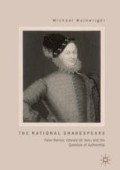Abstract
This chapter focuses on the game-theoretic relationship between William Cecil (the banker) and Edward de Vere (his player). Cecil accompanied the offer of his daughter Anne in marriage with a large dowry; this lure successfully tempted Oxford; the wedding took place in December 1571. The financial settlement dominated Oxford’s reasoning; this control suited the dynastic ambition behind Cecil’s gamesmanship, and that extraludic mastery soon became apparent to Oxford. Banker–player relations would condition Oxford’s life until Queen Elizabeth granted him an annuity in 1586. Hereafter, the player in statecraft became a banker in stagecraft, and Oxford realized his ultimate aim: he wrote. The Policy of the Plays required his anonymity, so the authorial Oxford adopted the sobriquet William Shakespeare.
Burghley was celebrating with great magnificence the marriage of his eldest daughter […] with the young Earl of Oxford, a connection which in after years brought him much trouble and anxiety.
—Martin A. S. Hume, The Great Lord Burghley (263)
Access this chapter
Tax calculation will be finalised at checkout
Purchases are for personal use only
Notes
- 1.
This quote comes from Richard M. Waugaman’s “Betrayal in the Life of Edward de Vere and the Works of Shakespeare” (2014).
- 2.
This promotion denies what David Norbrook understands to be the critical tendency to read Shakespeare’s plays, especially his later works, as celebrations of “the restoration of monarchical legitimacy as a return to a transcendent natural order” (245).
- 3.
With Bertram’s unwilling marriage to Helena, who is beneath his social standing, All’s Well That Ends Well extends its autobiographical trace into Oxford’s adult life.
- 4.
George Russell French first identified Burghley with Polonius in Shakespeareana Genealogica (1869). Looney (1920), E. K. Chambers (1930), John Dover Wilson (1936), Joel Hurstfield (1958), and Stritmatter (2001), among others, have subsequently supported French’s contention.
- 5.
In “Rabelais, Ramus et Raminagrobis” (1982), Peter Sharratt argues that Nancel’s Rabelaisian reference points to the 1552 edition of The Fourth Book of Pantagruel. One must note, however, that Rabelais’s ideological attack in the Prologue concerns Ramus’s acolytes, not Ramus himself.
Author information
Authors and Affiliations
Rights and permissions
Copyright information
© 2018 The Author(s)
About this chapter
Cite this chapter
Wainwright, M. (2018). The Banker and His Player. In: The Rational Shakespeare. Palgrave Macmillan, Cham. https://doi.org/10.1007/978-3-319-95258-1_7
Download citation
DOI: https://doi.org/10.1007/978-3-319-95258-1_7
Published:
Publisher Name: Palgrave Macmillan, Cham
Print ISBN: 978-3-319-95257-4
Online ISBN: 978-3-319-95258-1
eBook Packages: Literature, Cultural and Media StudiesLiterature, Cultural and Media Studies (R0)

